Peter MALONE
Saturday, 18 September 2021 19:59
Brooklyn
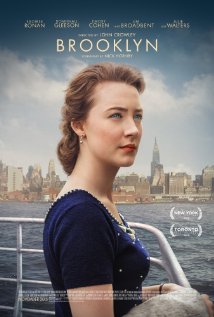
BROOKLYN
Ireland/UK/Canada, 2015, 111 minutes, Colour.i
Saiorse Ronan, Jim Broadbent, Julie Walters, Domnhall Gleeson, Fiona Glascott, Jane Brennan, Eileen O' Higgins, Peter Campion, Jessica Pare, Maeve Mc Grath.
Directed by John Crowley.
Yes, it is the Brooklyn of New York City, but the title of the film might also have been called the name of any town in Ireland. The setting is 1952. The prospects for young women in Ireland at the time were very limited and so quite a number of them migrated from the Irish towns to the United States and found success there, especially in New York City, especially in Brooklyn.
A lot of audiences who like good cinema will enjoy this film very much.
With the first part of the film in Ireland, the focus on a family, an older sister, Rose (Fiona Glascott) an accountant with a local firm as well is something of a golf champion, the mother (Jane Brennan) rather dependent on her daughters and Ellis, the younger daughter whose only job is on Sundays at the local bakery for the women coming out of mass, subject to the dictates of the owner, Miss Kelly, something of a snob as well as a gossip. It seems important that Ellis go to the United States – and Rose, with a priest friend in Brooklyn, Father Flood (a sympathetic Jim Broadbent) is able to arrange a ticket, accommodation and a job in an upmarket New York store.
Ellis has her friends, but is ready to go, something of a wrench from her family, are reserved and shy young woman venturing to a new world – especially the hard and seasick voyage.
Word needs to be said about the leading actress, Saoirse Ronan. She made quite an impact as a child actor, even getting an Oscar nomination for Atonement. She appeared in Peter Jackson’s The Lovely Bones and Peter Weir’s The Way Back. She now is in her 20s and has made the transition to adult actress with great skill and screen presence, communicating often with her expressions and body language rather than through words. She has received nominations for her performance as Ellis.
It is not as if high profile events happen in Ellis’s life. This is a story of ordinary people. Audiences will enjoy the scenes at the meal table at the boarding house, presided over by Mrs Keogh (Julie Waters at her best, controlling, religiously earnest, and chuckling at the boarders’ lives). Then there are the scenes in the shop with Ellis rather awkward at first, commanded by her supervisor (Jessica Pare) always to be smiling to attract customers back. At one moment, overcome by homesickness, Father Flood comes to the shop and he and the supervisor show concern for her – as they do later when news comes of Rose’s sudden death.
Ellis goes down to the parish dance on a Saturday night, a local parish, an Irish enclave, only to find a young man attracted to her, wanting to dance, talk, walk her home. He is Brooklyn plumber, Tony (Emery Cohen) – but an Italian! There is a nice courtship, Ellis gradually overcoming some awkwardness, dressing a little more colourfully, coming out of herself, even practising eating spaghetti as she is invited to Tony’s home and family.
There are some dramatic moments for Ellis, including Tony’s proposal for a marriage at City Hall, as well as Ellis’s return home, Rose’s funeral, meeting her old friends, mothers not resisting the urge to be matchmakers and introducing Ellis to a fine young man, Domnhall Gleeson. Which means that Ellis, in many ways enjoying being back in Ireland, has to make a decision as to whether she will stay or not, return to Tony…
While there are many serious undertones, this is a very likeable film, likeable and interesting characters – and, surprisingly these days, a very sympathetic picture of the Catholic Church and priests in the early 1950s, the Ministry and concern, not like those old parish priests back home in Ireland.
1. Ireland, the United States, the 1950s?
2. The audience immersed in this re-creation of the period? Wexford, the town, the contrast with Brooklyn, costumes, decor, manners, families, church?
3. The Wexford town, the streets, shops, homes, the church? The goal? The countryside? The voyage on the Atlantic, storms and calm? Brooklyn, Ellis Island and entry into the US, the streets, the boarding house, the church, the church hall and dances, the shop and sales, the Irish world, the Italian world by contrast? Musical score and times?
4. Ordinary people, ordinary lives, not a national focus nor an international focus? The appeal? Humane?
5. The 1950s, society, customs, Ireland and manners, morals, the harsh touches, gossip, a more genial church?
6. The 1950s, New York City, the boat, the woman on the boat advising Ellis or, manners, the arrival, the boarding house, the meals and chatter, the shops, the shop girls, the supervisor? The role of religion? The parish, Irish, the contrast with the Italians, Father Flood as a genial priest, Irish background, in the United States, his help? The prestige store, the customers, Ellis having to smile, night school? The Italians and the connection?
7. The visuals of the 1950s, costumes, decor, the political and social background?
8. Ellis’s story? Saoirse Ronan? Her age, growing up, life in Ireland, relationship with her mother, Rose as the older sister, care for her, is and her accounting work, golf? No future for Ellis? Her work on Sunday in the shop, Miss Kelly, making way for the rich, snubbing of the customers, her sharp tongue? Ellis and Rose organising the trip to America with Father Flood? The effect of leaving her mother with Rose to care for their mother? Being shy, the wrench from home, on the boat, eating, the issue of the bunk, the smart girl and her advice, sick, settling down, the landing, going through the passport control? Mrs Keogh, the room, the table, the chatter, her work, being urged to smile, the role of the supervisor, her being homesick, Father Flood coming, the supervisor more sympathetic? His suggestion about study, the night classes, friends at the school, improving her studies, doing well?
9. Ellis as a character, shy, experience, learning and changing? Her style, hair, clothes, moving to brighter colours, being given the privilege of the basement room? Her friendship with the girls, their comments at the table, their friendships, their past experiences? Delores and her being difficult? Mrs
Keogh and her chatter, control, humorous lines, attitude towards religion?
10. The letters home, Rose reading them? the suddenness of Roses death? Grief, Father Flood coming to break the news? And the phone call home, the distance, the decision to go?
11. Ellis going to the dance, with Dolores, the other girls? Tony and his approach, pleasant, talking, dancing, the two clicking? His Italian background, plumber? His walking Ellis home? Her shyness, the meetings, his escorting her, declaration of love, her surprise? Her able to return the compliment? Going to the family dinner, the brother and his mischief and apology? Tony and his love for baseball? The kiss? Ellis’s reflection, her love, the spur of the moment, going to City Hall, the wedding, meeting the Irish at the office and the later repercussions with Miss Kelly and information?
12. Going home, memories of her friendship with Nancy, Nancy and George going out? The meeting Jim Farrell, a good man, comments on the blazer and brilliantine? Going out, the meals, talking, walking along the beach, being comfortable with him, the various matchmakers, the two mothers and their concern? His expectations, and not telling him? Facing the dilemma about her marriage? The delay in answering Tony is letters, the scenes of him and his composing letters at home? Her keeping the letters in the draw? Going to Nancy’s wedding?
13. Miss Kelly, the confrontation, jolting Ellis into realising the truth, telling the truth, telling her mother, Jim? Buying the ticket, the sad goodbye to her mother the night before?
14. On the train, looking at Ireland, remembering, the young girl in on board in Ellis giving her the same advice she received? Arrival, standing opposite the plumber shop, embracing Tony?
15. A film of warmth and humanity?
Published in Movie Reviews
Published in
Movie Reviews
Tagged under
Saturday, 18 September 2021 19:59
McHale's Navy/ 1997
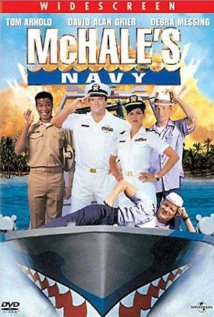
McHALE'S NAVY
US, 1997, 108 minutes, Colour.
Tom Arnold, Dean Stockwell, Debra Messing, Ernest Borgnine, David Allen Grier, Tim Curry, Bruce Campbell.
Directed by Bryan Spicer.
Mc Navy was a very popular television series starring Ernest Borgnine. This was a remake for the thousands of fans of the television series and those interested in a remake – which, in fact, not entirely undeservedly, was nominated for a Razzzie Award for the worst remake of the year.
Tom Arnold is Mc Hale – revealed at the end of the film to be the son of Cobra, a high-powered official in the Pentagon, playing by Ernest Borgnine himself. Tom Arnold, who could pass for Borgnine’s son, suits the role of the former naval officer now become scrounger and supplier of all kinds of goods, alcohol, ice cream, sexy pictures… to sailors on the Caribbean island, his former crew, but now idling away their time.
A new officer is sent, someone who is prone to accidents and has an elevated opinion of himself – with Dean Stockwell hamming it up in the role. His assistant is Debra Messing, at the time of the beginning of the series Will and Grace. She begins as a by the book officer, shocked at the behaviour of the sailors as well as of Mc Hale, but soon sees through her commander, is interested in Mc Hale and helps him in his quest. Amongst the sailors on the island is David Allen Grier, miming his way, over the top, through his performance as an inept officer who is used as a spy by the new commander, but helps Mc Hale and his group, even rescuing (or being rescued) by the young boy that Mc Hale is caring for after the death of his father in the campaign in Panama – but promising to look after him and his family not knowing at the time that the family was the extended group in the village. The new commander is hostile to Mc Hale, tries to imprison him, then receives news from Cobra that there is a terrorist on an adjacent land and that Mc Hale is to lead the attack against him.
Actually, the film opens with the terrorist arriving, with three international backers, and taking control of toadying mayor of the island – and in answer to complaints by the villagers that his bases to close, he bombs or the buildings to move the villagers away. He is played for satirical laughs by Tim Curry, over the top, but acceptably so for the character and for Tim Curry’s performance – along with a British psychologist who has two counsel him hour by our.
The world’s second terrorist was trained at Quantico, knows the American secrets, has his own private army, had previously tangled with Mc Hale in Panama. He sets up missiles and fires them onto Mc Hale’s house as well is his boat. In the meantime, Mc Hale’s Navy does some espionage on the terrorist site, even going to Cuba to get some technical replacements – with the opportunity of Grier mimicking Fidel Castro.
As it is, the terrorist explodes his bomb onto his colleagues, wanting not a new world order but no world order.
The film culminates with the commander detonating all the weapons, Cobra flying to the island and almost shot down in his helicopter, boat chases between Mc Hale and the terrorist – with the ultimate elimination of the terrorist, people getting medals, Debra Messing riding off with Mc Hale – and the commander reduced to playing baseball with the children on the new baseball field.
Published in Movie Reviews
Published in
Movie Reviews
Tagged under
Saturday, 18 September 2021 19:59
Swordfish
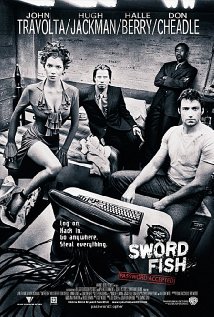
SWORDFISH
US, 2001, 99 minutes, Colour.
John Travolta, Hugh Jackman, Halle Berry, Don Cheadle, Sam Shepard, Vinnie Jones, Drea de Matteo, Rudolf Martin, Zack Grenier, Camryn Grimes.
Directed by Dominic Sena.
No, this is not a fishing film - although one of the villains does get shot while fly-fishing in an environmentally protected river. Swordfish is a codename for access to a secret FBI division which built up a huge financial resource in the 80s to fight international terrorism with US terrorism. It is a conspiracy movie. And, because this is 2001, it is a computer conspiracy thriller. This is already becoming a trend. Earlier in the year we had Antitrust in which Tim Robbins as a rogue Bill Gates type hired young geniuses to program his plan for taking over world communications. Naturally, it was Ryan Philippe as the young nerd-hero who took him down. This is the formula although the hacker in this film is a bit older and the villains want world power to protect American freedoms and the American way of life at all costs.
The plot is far-fetched and is full of plot-holes. But, it keeps the interest while it is on screen. What makes it different is that the screenplay keeps referring to movies about bank hold-ups and hostages, about happy endings and heroism. It keeps drawing attention to itself so that we are watching the plot but all the time being reminded that it is only a movie, a spectacular special effects movie often enough and that it is being far more sensational than the movies of 25 years ago.
In fact, this is how the film starts, a long explanation by John Travolta of how the hold-up movie of 1976, Dog Day Afternoon, worked and how today it would be made more shockingly and brutally with the media hyping the events - which is what we are then shown because Swordfish is actually starting with a bank robbery and Travolta is the arch-villain. He is telling all this to Hugh Jackman who has hacked into the swordfish funds for him. Travolta is also fond of referring to Harry Houdini who could, he says, make an elephant disappear in front of a crowd (in the film a bus on a freeway 'disappears' in front of the pursuing police). It is done by 'misdirection'. The ultimate introverted organisation manages by unscrupulous misdirection.
Then it's back four days so that the film can show how this confrontation came about and build up to it again. The conspiracy plot takes us to Washington DC to the FBI to the world's top hackers. And it centres on John Travolta as a mysterious criminal mind with bizarre ethical standards. Travolta reminds us once again how he can command screen presence and audience attention. Hugh Jackman is ultimately sympathetic as the hacker. Don Cheadle is the serious FBI opponent.
The director is Dominic Sena, a commercials director with a fondness for car chases (Kalifornia, Gone in Sixty Seconds). Not only does the plot draw attention to itself but Sena uses a great number of very flashy photographic tricks to remind us that this is still a movie.
Swordfish, while it purports to show us corruption in high places and make serious comment on the US, it is really the visually stylish equivalent of an airport bestseller.
1. The beginning of the 21st century, and issues of terrorism, hacking computers and files, the conspiracies of the Right Wing? Released only months before 9/11?
2. The Los Angeles settings, police, the FBI, the airport, offices, clubs, computer rooms? Texas, the drab situation the trailer? The Senator and his fishing in the prohibited river? The musical score?
3. An action show? The introduction, Gabriel and John Travolta’s presence, sitting and his monologue about movies, Dog Day Afternoon, audience expectations, Al Pacino, the siege, the hostages, the desire for a happy ending? The difference between the movies of 1975 and 2000? Gabriel and his relishing this description of the movies?
4. Gabriel, the guns trained on him, his walking out, with Stan, the FBI, the commander, the decision about the hostages, their being wired with bombs, agent Roberts and his trying to stop the situation, failing, the vast explosion?
5. Los Angeles airport, the visitor, his two passports, his being interrogated, the FBI, his attempt to escape, telling the FBI about his boss, agent Roberts being called to the phone, Gabriel’s hit man and the killing of the hacker and his lawyer?
6. The transition to 4 days earlier? Stan, dishevelled, hitting the golf balls, the wreck of the trailer? In Leavenworth for two years, hacking? Ginger, her glamour, her approach, hitting the golf ball, her proposal, Stan ousting her? The issue of his daughter? The offer of $100,000?
7. Stan, flying into Los Angeles, with Ginger, their being photographed by the FBI? Meeting Gabriel, the proposal, the gun at his head, the demand for a test in hacking, counting down the seconds, his ultimate success? His reputation, Roberts arresting him? Prison? His motivations about programs that took away people’s rights? Phoning his wife, her drinking, married to the pornographer, wanting to talk to his daughter, going to visit, her happiness in seeing him, the pursuit, rolling down the hill, the agents rolling after him? Their proposal?
8. Gabriel’s plan, the military codes, the interest on the money from the 1980s, cumulative interest, the transfers? Gabriel’s explanation about financing a war, his theories about his protecting the American way of life? His armaments?
9. Ginger, as an ally, working for the DEA, persuading Stan to come, the sexy scenes, her encouraging Stan, Gabriel stringing her up, shooting her – and her getting the money at the end and being with him?
10. The Senator, his assistant, the phone call, the plans, his anger, his plan to kill Gabriel, Gabriel accosting him while he was finishing, his death? The assistant in the exploded car?
11. The importance of timing, Stan and his success, the resuming of the siege situation, the threats to Stand, his daughter, Ginger? Success, making the transfers, his change of the program and the continued transfers? Gabriel forcing him to make his final decision?
12. The plan for the plane, the FBI following, Gabriel and his theories of misdirection, getting the bus, the helicopters, the grappling irons, lifting the bus into the sky, one of the irons breaking, the dangers and crashing through the city, landing on the roof? Stan and his getting the missile, shooting of the helicopter? His going to identify Gabriel? The Israeli citizen?
13. The postscript, Monte Carlo, Gabriel on the yacht, Ginger and the money, the news of the explosion – when did this happen? Was Gabriel dead?
Published in Movie Reviews
Published in
Movie Reviews
Tagged under
Saturday, 18 September 2021 19:59
Live, Love and Learn
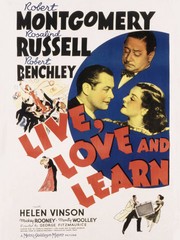
LIVE, LOVE AND LEARN
US, 1937, 78 minutes, Black and white.
Robert Montgomery, Rosalind Russell, Robert Benchley, Helen Vinson, Monty Woolley, E.E.Clive, Mickey Rooney.
Directed by Geo. Fitzmaurice.
Live, Love and Learn is a romantic, screwball MGM style, comedy of 1937, supporting feature in the same year that the two stars appeared together in the drama, Night Must Fall.
The screenplay is slight, played for agreeable laughs by Rosalind Russell who was emerging as a leading actress at this time, and Robert Montgomery who tends to seem rather serious, even in comedies.
He is a painter, trying to be a Cezanne and Renoir, trying to make ends meet. He is out in the countryside painting when riders leap over a wall, especially Rosalind Russell, who falls of her horse. He comforts her – and they fall in love, go to a nearby farm for help, get married. She is a very wealthy woman who has never wanted anything in her life.
They go to his apartment for their honeymoon, but find the boarder, Robert Benchley in one of his typical comic roles, as the friend. The couple tries to live ordinarily, in the small apartment, the small kitchen, the cramped bedroom situation…
After a riot in the park, Montgomery becomes recognised as a painter, is feted by people and critics, takes himself particularly seriously, becomes very interested in money as he works for a personal show. This is not what Rosalind Russell bargained for and, of course, there are quite some clashes. But, it is a comedy, and priorities and love get sorted out.
There are interesting character actors in support, Helen Vinson as Lilly, the assistant; comic turns from Monty Woolley, soon to be The Man Who Came to Dinner; a role for E.E. Clive and for a very young Mickey Rooney, about to become Andy Hardy.
Published in Movie Reviews
Published in
Movie Reviews
Tagged under
Saturday, 18 September 2021 19:59
Get Santa
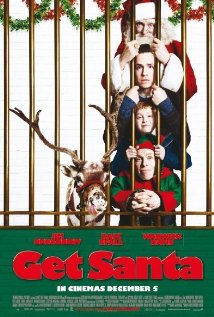
GET SANTA
UK, 2014, 102 minutes, Colour.
Jim Broadbent, Rafe Spall, Kit Connor, Ewan Bremner, Warwick Davis, Stephen Graham, Joanna Scanlan, Jodie Whitaker, Nonso Anozie.
Directed by Christopher Smith.
It is not often that somebody comes up with an original and contemporary fairytale about Santa Claus. But this is the case here, from the imagination of Christopher Smith who has been more noted for his horror films including Creep, Severance, Triangle and his excursion into the Middle Ages with Black Death.
Jim Broadbent seems entirely suited to be Father Christmas and obviously enjoys himself here, as Santa, as a prisoner, toughing it out with other prisoners, anxious about Christmas not failing. He employs the help of the boy that he remembers from the past, Steve, played by Rafe Spall, getaway driver in robberies, getting out of prison and wanting to see his son, Tom, Kit Connor. His mother, Jodie Whitaker, refuses. He also has to report to his parole officer, played with the touch of vain grimness by Joanna Scanlan (so effective as Dickens’ wife in The Invisible Woman). Ewan Bremner is the caricature policeman.
There are various adventures as father and son find the reindeer in Richmond Park, the leader, Dasher, identifying himself with farts. Then they find the broken sleigh. After visiting Santa in prison, they make an effort, taking Dasher in the truck, its breaking down, trouble with the police, encountering pantomime characters in a small town, drag, getting a lift to Suffolk where they have been told to go.
Santa escapes with a dwarf who proclaims he is not an elf. Eventually, Santa and the non-elf, mother and boyfriend, Steve, Tom, all finish up in a car being pursued by the police – with Santa getting the opportunity to prove that he really is who he is.
1. The title, the variety of meanings? Christmas Day to be a success? Santa and his being arrested, the police?
2. Contemporary fairy story, fantasy? Father Christmas, the sleigh, the reindeers? The accident, Santa needing help? The London locations, homes, the streets, the jail? The country town, the countryside? And the land and workshop of the elves? The musical score?
3. Audience response to Santa, belief or not? Impact of the adults, the children?
4. Steve, in jail, the getaway man, getting out, his Rubik cube? Phoning his wife, wanting to see his son? Wanting to visit? His promises and failing to keep them? His son’s disappointment? The visit with the parole officer, the severity of her attitudes?
5. Father Christmas, Jim Broadbent enjoying himself? Look, the accident, the reindeer and the crash, in the park, the sleigh the trees? In the shed, with Tom, phoning his father, Santa wanting to see Steve, telling him the story about his last Christmas and the gift of the Rubik cube?
6. Steve and his disbelief, Tom and his urging? Finding the deer? Santa and his arrest? Steve and Tom, the truck, the search for the deer?
7. Santa in jail, his manner of talking, people thinking he was mad, later identifying him with a similar-looking criminal, his Santa clothes, changing into prison garb, going to see Barber, Barber talking with Steve on the phone, willing to help? The hair design? Santa and practising tough faces and stances? Steve and Tom visiting, the promise to help?
8. The big prisoner, confronting Santa, wanting him to be part of the Christmas party to help with the kids? Santa telling stories of each of the criminals and their Christmases? His skills in making paper decorations? The discussions with Sally, his not being an elf? The plan for escape, the tunnel, the roof?
9. The characters of the police, the caricatures? The parole officer, coming to the prison? The collaboration, the phone calls, getting in touch with Steve, the threats? The pursuits?
10. Steve, Tom, the van, fighting – and the test, the fights, in the truck, the breakdown, the policeman, – and hitting him, their walking into the town, the pantomime and the drag, disguised, walking out of the town, the Scandinavian who passed them by, picking up and wishing them well?
11. Going into the Suffolk countryside, the tower, the phone call, Steve willing to give up, the discovery of the notice, the last stop before Christmas, the tunnel and father and son falling through to the elves? The characters of the elves, that life, Santa, the sleigh, the new sleigh and its failure, the plan?
12. Finding the sleigh, the deer? Tom’s mother and boyfriend, the boyfriend helping? Santa and the elf, getting out, in the street? Tom, Steve? Everyone together in the car? The police pursuit, Santa and his machine gun – and the reindeer poop pellets?
13. Everybody arriving at the site, the real Father Christmas, his persuading the police and the parole officer to be nice? Taking off – and Christmas saved (even after Jon Snow on Channel 4 announcing that, earlier, Christmas had failed in the Pacific and in Australia)?
Published in Movie Reviews
Published in
Movie Reviews
Tagged under
Saturday, 18 September 2021 19:59
Dreamcatcher/ 2015
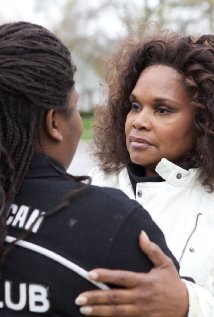
DREAMCATCHER
UK, 2015, 104 minutes, Colour.
Brenda Myers- Powell.
Directed by Kim Longinotto.
Dreamcatcher is a documentary well worth seeing, to be recommended.
The focus of the film is a very strong personality, Brenda Myers- Powell, an underprivileged African- American woman, with a hard upbringing, very early in her life on the streets, brutalised by pimps, addicted to drugs. 25 years. At one stage she experienced violence and found herself in hospital. She made a decision to change her life.
This documentary has been made by Kim Longinotto, a British filmmaker who has won awards for her documentaries, including five from the Chicago International Film Festival from 1993 to 2001.. She is in an unobtrusive director, giving all the screen attention to Brenda and the many people that she meets.
The project was set up by writer Lisa Stevens who made a documentary Crackhouse USA in 2009 and met the co-founder of Dreamcatcher Foundation, Stephanie Daniels Wilson, along with Brenda Myers- Powell. She spent several years getting to know the women and observing their work and finally wrote a screenplay.
Brenda is the face of Dreamcatcher, relying on her exuberant personality, not afraid to be in a person’s face, with 25 years of a hard life to draw on to be persuasive in talking with young women who have become prostitutes or who are at risk. Touring the streets of Chicago meeting young women, talking with them, encouraging.
Brenda is married and has a daughter that is good family support. Brenda is the person she is, as observed with great sympathy. This is evident when she meets, for instance, schoolgirls, after school groups who are very frank, discussing the situations with them, warning them to be wary. An interesting character, Homer, a former pimp is now helping Brenda.
One focus is on Diana, who had been molested as a girl to a point where she thought this was okay and the totality of her life. She confides in Brenda who is able to open her eyes gradually to what life could be.
This Chicago is a world of streets, of prostitutes, bars and fast food outlets, sexism, racism, classism. Brenda, genially engages her director as well as the audience, wanting to contribute to the release of girls and women from their sex work.
Published in Movie Reviews
Published in
Movie Reviews
Tagged under
Saturday, 18 September 2021 19:59
Third Wheel, The
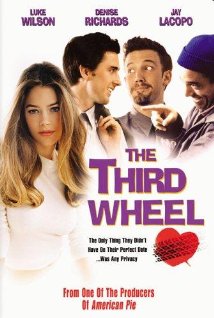
THE THIRD WHEEL
US, 2002, 91 minutes, Colour.
Luke Wilson, Denise Richards, Jay Lacopo, Ben Affleck, Matt Damon, Melissa Mc Carthy.
Directed by Jordan Brady.
The Third Wheel is a romantic comedy with variations. It was produced by Ben Affleck and Matt Damon who both appear in the film, the latter uncredited.
The film is a star vehicle for Luke Wilson, emerging in comedy and romance at this time, the shy worker who wants to take out the woman from the office to whom he is attracted. She is played pleasantly by Denise Richards.
When they finally go out, there is a series of mishaps but Diana is agreeable and Stanley tries to overcome his awkwardness. When they hit a homeless man, Phil, played by Jay Lecopo, who wrote the screenplay, there begins a series of adventures and misadventures, Phil seeming awkward but always cheerful, trying to help the date. This includes his monologue performance at an open-air theatre, his talking about bread while a series of slides are shown in the background – and the audience applauds. He also says he has a bag full of glass animals, giving him by Laura – with Stanley eventually realising that he is talking about Tennessee Williams’ The Glass Menagerie.
Phil keeps intervening like a hobo guardian angel and eventually the couple have a happy ending – and he goes on to be hit by the car of the two slackers at the tow away yard. It all ends with happy dancing behind the final credits – and audiences will appreciate seeing Melissa Mc Carthy some years before her major impact in Bridesmaids and her subsequent successful star career.
1. An easy going romantic comedy – with some tensions?
2. The title, Stanley and Diana – and the addition of Phil and his contribution to the date and changing people’s lives? The down-to-earth equivalent of a guardian angel?
3. The city settings, the office and its work, board meetings, apartments? The date, drinks, the play, the tow away, the restaurant, the apartment…? The musical score?
4. The focus on Stanley, ordinary, shy, at work, the workmates, especially Michael? The group and their interest in Stanley, his romance? His seeing Diana, the attraction, his awkwardness, not making headway, the next day, six months, the year? His determination, egged on by Michael? Michael giving him the joke, the awkwardness of the meeting with Diana, telling her the joke and her laughing?
5. Agreeing to the date? His getting ready, clothes, the car, the flowers? Her getting ready, choice of clothes? His picking her up, the talk, the silences, breaking through the silence? The drink? The woman pressurising Stanley to buy all the roses? The one white rose – and Stanley organising Michael to have it at the end?
6. The workers of the office, placing all the bets, the chart? Spying on the couple? Relaying the information?
7. In the car, hitting Phil, his reactions? The story of the glass menagerie and Laura giving him the animals? In the bag? The attempts to help, Stanley going to ATM to pay for the broken animals? Diana and her concern? The taking him to the hospital, his reactions, X-rays, the nurse?
8. Phil, his character, appearance, on the streets, the glass menagerie? Being hit, his interactions? In the car, his comments, seeing Stanley as uptight? Wanting to make Diana laugh? Helping with the date – despite Stanley saying they were just friends?
9. Going to the concert, parking in the tow away space and Stanley not noticing? getting their seats, Michael and Marilyn at the play? The different performances, the monologues, boring? Phil going backstage, picking up the bread, coming out on the stage, his descriptions of the various kinds of bread, the slideshow behind, relating his talk to the slides, people’s reactions, the standing ovation? His response, and the car towed away?
10. Going to the yard, the two in attendance, slackers, Hank on his break, Diana and her being attractive, getting the car, pushing Hank out? Trying to get rid of Phil? His continued interventions, thinking he was doing good?
11. At the diner, Phil joining the couple, Kevin’s arrival, the breakup with Diana, his rudeness, Phil accosting him, his weeping?
12. Taking Diana home, her wanting to find Phil somewhere to stay, Stanley returning, seeing Phil in the house, his accosting Diana, coming in, the fight?
13. Phil, at the shop, getting the bottles and breaking them, his new broken menagerie, meeting the two tow away men, their hitting him, their reaction – and
his beginning to change their lives?
14. Happy dancing during the final credits?
Published in Movie Reviews
Published in
Movie Reviews
Tagged under
Saturday, 18 September 2021 19:59
Mississippi Mermaid/ La Sirene de Mississippi
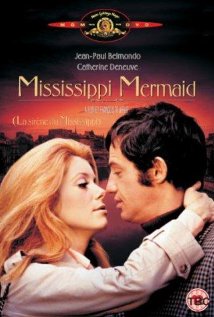
MISSISSIPPI MERMAID/LA SIRENE DE MISSISSIPPI
France, 1969, 123 minutes, Colour.
Jean- Paul Belmondo, Catharine Deneuve, Nelly Borgeaud, Michel Bouquet.
Directed by François Truffaut.
Mississippi Mermaid is based on a story by William Irish – and later adapted for the Angelina Jolie- Antonio Banderas melodrama, Original Sin . It is directed by François Truffaut who had emerged with the French New Wave in the late 1950s with The 400 Blows and developed a strong reputation with such films as Shoot the Pianist and Jules and Jim. He was to continue until the 1980s and his untimely death. He is also remembered for his book of interviews with Alfred Hitchcock and his appearance as the scientist in Spielberg’s Close Encounters of the Third Kind.
Jean- Paul Belmondo portrays a factory owner on the island of Reunion. The film gives a history of the island, its inhabitants, its role in the French Revolution and of the families settled their. Belmondo has negotiated for a bride from France but did not tell her that he was the owner of a factory. He is surprised when she seems not to have arrived on the ship but is suddenly there in the presence of Catharine Deneuve.
After they marry, they live a set life but the wife seems unsettled and disappears. She has robbed him of his fortune and gone back to France with a man who controlled her to take the place of the intended bride and has taken the money.
The factory owner pursues her to France, after the dead woman’s sister has commissioned a private detective to find her. When Belmondo finds her, he becomes infatuated even to killing the detective so that they would not be exposed. He returns to Reunion, sells his factory, comes back to France and the couple flee to the countryside, eventually into the winter hut where Deneuve begins to poison Belmondo because she is restless and wants a life of luxury – he accuses her, accepts what is happening, but she then saves him as they flee through the snow.
1. Audience interest in the work of François Truffaut, of Jean- Paul Belmondo, of Catharine Deneuve – and their working together? A film of the 1960s? The stories of William Irish/Cornell Woolrich?
2. The island of Reunion, its history, locations, exotic, the families, wealth, the heritage of the French Revolution, banks and factories? The beauty of the landscapes? The musical score? France, Provence, Antibes, the countryside, the winter snow?
3. The title, the ship with Julie coming to Reunion?
4. Louis, Jean- Paul Belmondo and his charming and athletic presence, his family, the heritage, the factory, his hopes, the letters to France, the prospective marriage? His partner at the factory? His finances? The boat, Julie not seeming to arrive, Catharine Deneuve waiting, the story about the photo, his deception that he was the owner of the factory?
5. The marriage, the ceremony, life in Reunion, the mansion, the tour of the factory, Julie’s absences, the relationship, her spending money, the signatures on the accounts?
6. Julie, her character, departure, taking all the money?
7. The repercussions, Louis’ friend, taking the money, going to France?
8. Julie’s sister, the truth, the murder? Hiring the detective? His pursuit, the irony of his success, and Louis killing him to silence him?
9. Louis the search, France, the effect, Antibes and the club, the hotel, her life, following her, scaling the wall, accosting her?
10. The true story, Richard, the blackmail, the plan and the deception, the murder?
11. Louis in love with her, affection to love, their life together, the money, her restlessness, wanting luxury, the scenes in the club, his going to Reunion, getting the money, bringing it back to her?
12. Living together, leaving Antibes, the police, Lyon, in the hut, her attempts to poison him, his understanding the truth, accepting it – her hitting the coffee cup – and their fleeing into the snow?
Published in Movie Reviews
Published in
Movie Reviews
Tagged under
Saturday, 18 September 2021 19:59
Invitation to the Dance
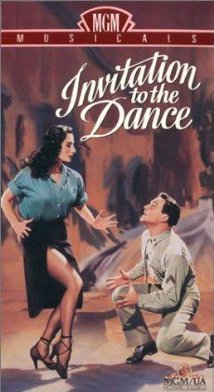
INVITATION TO THE DANCE
US, 1956, 93 minutes, Colour.
Gene Kelly, Igor Youskevich, Clare Sombert, Tamara Toumanova, Diana Adams, Tommy Rall, Andre Previn, Carol Haney, David Kasday.
Directed by Gene Kelly.
Invitation to the Dance is a film for specialist audiences, for those interested in different dance styles, from tap to ballet, and its development in films to the 1950s. It is also a film for fans of Gene Kelly.
The film was actually made at the end of 1952 and 1953, with the producers and MGM not confident about its box office success, it was not released until 1956 – and did not do particularly well, financially. However, for many it has a strong reputation and can still maintain audience interest.
It was a labour of love for Gene Kelly who did not initially intend to appear in all three segments but was urged by the producers. He directed the film – foreshadowing some of the other films he was to direct as he grew older, including Barbra Streisand in Hello Dolly. He also did the choreography, something he shared in such films as On the Town and Singin’ in the Rain with director, Stanley Damon.
The film is a showcase for Gene Kelly himself, his screen presence, his skills in dancing, with the touch of the acrobatic, in the first segment, Circus, as a marine in the second film, Ring Around a Rosy, in many ways reminiscent of the Slaughter on 10th Avenue, and as a sailor in Sinbad the Sailor, a variety of dancing styles with the young boy, David Kasday, who plays the Genie, and a lengthy cartoon sequence with a Princess and two Arabian swordsman – echoes of his dancing with Tom and Jerry in Anchors Aweigh.
The Circus has quite some pathos, showing lovers, with the Clown pining for the girl, offering her flowers and almost attracting her, but she is distracted by some spectacular walking and gymnastics on the tightrope. There is an interlude where the Clown holds many props and these are taken by fellow-dancers and there are some exuberant performances by the ensemble. Finally, the Clown goes on to the tightrope but falls on a red cloak, symbolising blood, and dies
The second segment, Ring Around Rosy, is a contemporary story, with a large cast initially introduced, with a number of dance names including Tamara Tamanouva and Belita. Kelly himself takes a rather minor role as a marine. The setting is affluent contemporary society, at clubs, with a range of well-dressed and chattering guests, a crooner, and a series of passing on of a bracelet to a number of characters and its finally returning to the initial giver. There are some ballet pieces as well as tap dancing and Kelly partners a streetwalker.
The third sequence is Sinbad the Sailor, with Roger Eden’s adapting the music of Rimski- Korsakoff. The scene is the Arabian Nights with Carol Haney as Scheherezade. Kelly portrays a contemporary sailor, being persuaded to buy many items in the marketplace but the authorities making him pay for a lamp which has been stolen. Each times he rubs it, a genie appears, and a Princess, then a painting into which Kelly and the genie go, which then becomes an elaborate animation sequence, the man and the boy dancing, the boy following the movements of the man, then with the Princess, then with the Arabian swordsman. It is an entertaining tour-de-force of dance and animation.
As has been said, a film for a specialist audience interested in dance and Gene Kelly.
Published in Movie Reviews
Published in
Movie Reviews
Tagged under
Saturday, 18 September 2021 19:59
Wagon Wheels
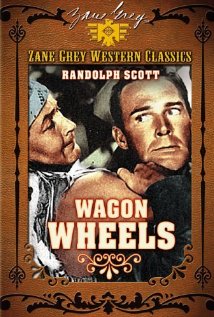
WAGON WHEELS
US, 1934, 59 minutes, Black and white.
Randolph Scott, Gail Patrick, Billy Lee, Monte Blue, Raymond Hatton.
Directed by Charles Barton.
Wagon Wheels is a brief western from the early 1930s, based on Zane Gray novel. It is a brief picture of migrants leaving Independence, Missouri, on their way to Oregon in 1844. The film captures the atmosphere of many similar treks in the 1840s and 1850s.
There are some effective sequences of the wagons, the trek, the focus on the wheels, the threats from attacking Indians, the friendship between the travellers. Randolph Scott, who was beginning to star in brief westerns at this time (and also to move into musicals with Fred Astaire and Ginger Rogers, Follow the Fleet) is one of the scouts leading the group. He has some action sequences, especially fighting one of the travellers who is part Indian and is in league with Indian tribes urging attacks on the travellers to prevent them getting through.
Gail Patrick is a widow with a young son whom she abducts from her husband’s family, is criticised by Scott for travelling but buys another wagon and becomes part of the group. The little boy, Billy Lee, is rather precocious – even with his sling firing at the Indians.
There are some grizzled travellers and guides, two sisters, one pioneer who is actually killed by the Indians, the other with her head in a book and writing the history of the trek, found attractive by one of the guides – with some happy prospects at the end.
There are quite a few songs throughout the film, including Wagon Wheels, an indication of how the travellers entertained themselves during the long route.
The film offers a tribute to the pioneers of the period – its presentation of the Indians is more traditional, their being presented as conniving, ferocious, and their deaths something to be welcomed.
Zane Grey was very popular in novels and films of this period. Charles Barton directed a number of short films from the 30s into the 50s and then into television, including Mark and Pa Kettle.
Published in Movie Reviews
Published in
Movie Reviews
Tagged under